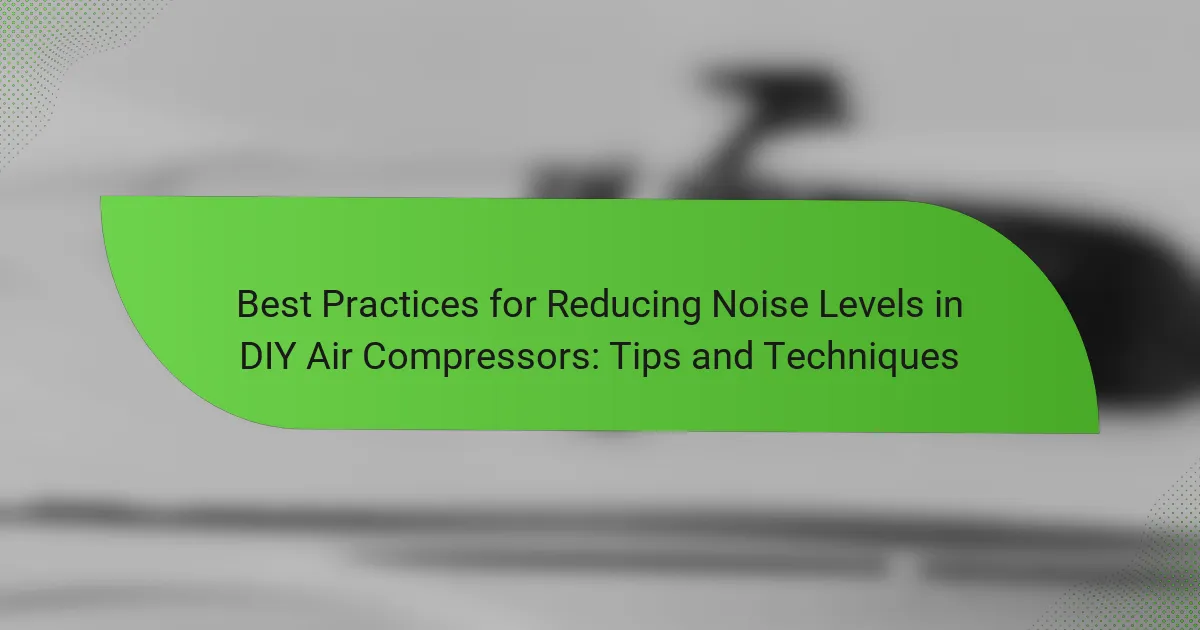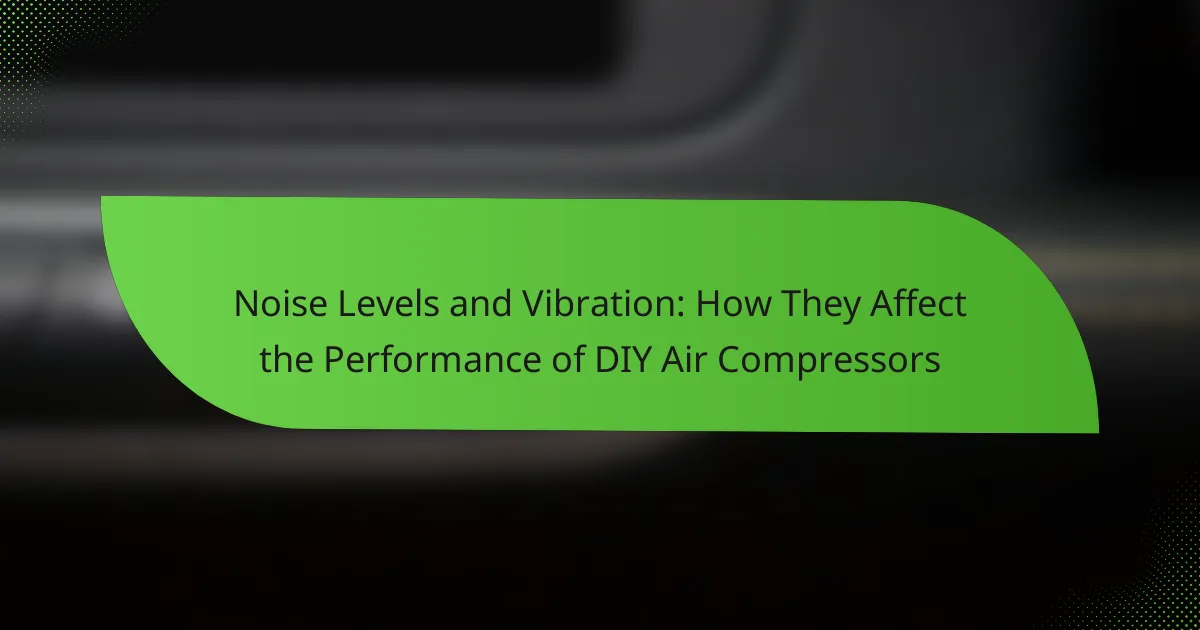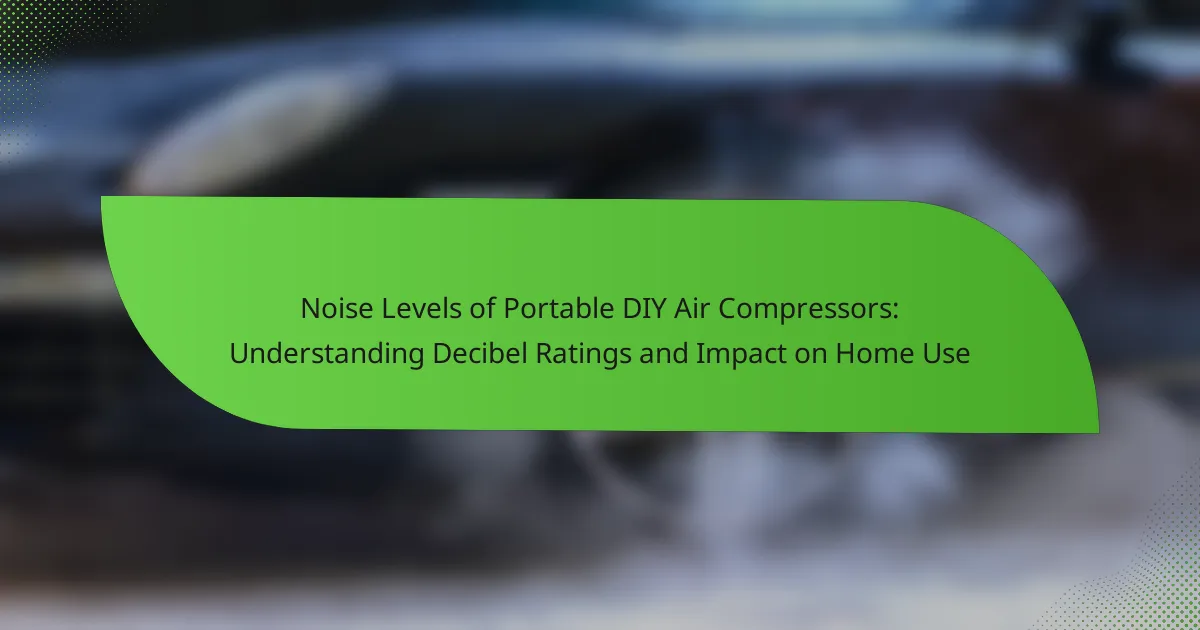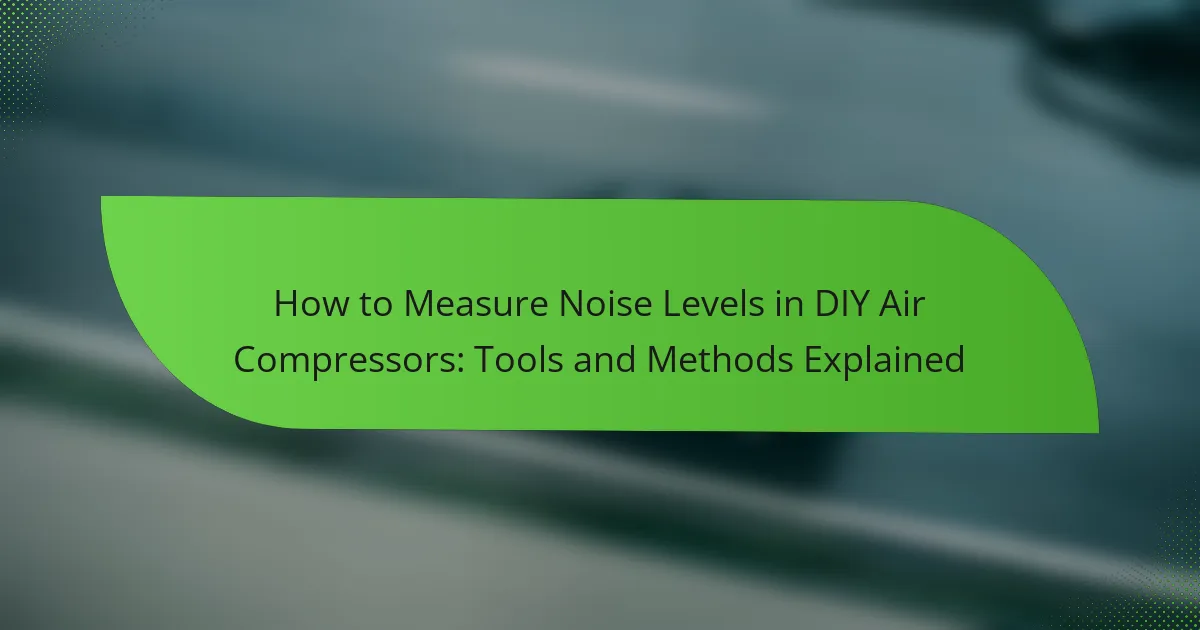DIY air compressors operate at noise levels between 70 and 90 decibels, comparable to the sound of a vacuum cleaner or heavy traffic. The noise varies based on compressor type, with oil-lubricated models generally being quieter than oil-free ones. Common noise sources include the motor, vibration, and air discharge, which can lead to hearing damage with prolonged exposure above 85 decibels. Strategies for managing noise levels include selecting quieter models, using vibration-absorbing mats, enclosing compressors in soundproof boxes, and performing regular maintenance. This overview provides essential insights into the noise characteristics of DIY air compressors and effective noise reduction practices.
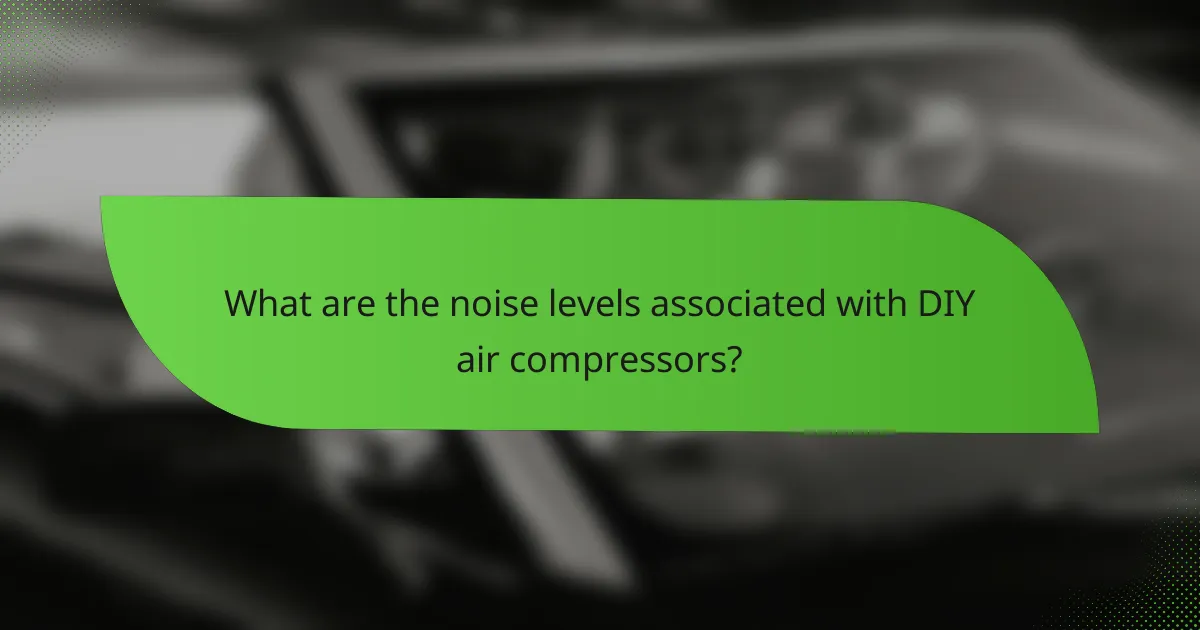
What are the noise levels associated with DIY air compressors?
DIY air compressors typically operate at noise levels ranging from 70 to 90 decibels. This range is comparable to the sound of a vacuum cleaner or heavy traffic. The noise level depends on the compressor type and its design. For instance, oil-lubricated models tend to be quieter than oil-free models. Additionally, larger compressors may produce more noise due to their powerful motors. According to a study by the National Institute for Occupational Safety and Health, prolonged exposure to noise levels above 85 decibels can lead to hearing damage. Therefore, using ear protection is advisable when operating DIY air compressors.
How are noise levels measured in DIY air compressors?
Noise levels in DIY air compressors are measured using sound level meters. These devices capture sound pressure levels in decibels (dB). Measurements are typically taken at a standard distance from the compressor, often one meter. The readings indicate the operational noise produced during use. For accuracy, measurements should be taken in a controlled environment. This ensures external noise does not affect the results. Manufacturers often provide noise ratings in product specifications. These ratings help consumers compare different models effectively.
What units are used to express noise levels?
Noise levels are expressed in decibels (dB). The decibel scale quantifies sound intensity. It is a logarithmic scale, meaning each increase of 10 dB represents a tenfold increase in sound intensity. For example, normal conversation is about 60 dB, while a rock concert can reach 120 dB. This measurement is crucial in various fields, including acoustics and engineering. Understanding decibel levels helps in assessing potential noise pollution and its impact on health.
What factors influence the measurement of noise levels?
The measurement of noise levels is influenced by several factors. These factors include the type of sound source, distance from the source, and environmental conditions. The type of sound source determines the frequency and amplitude of the noise. Distance affects the intensity of sound due to the inverse square law. Environmental conditions like temperature, humidity, and wind can alter sound propagation. Additionally, the presence of barriers such as walls or vegetation can absorb or reflect sound. Measurement equipment calibration also plays a crucial role in accuracy. For instance, a sound level meter must be correctly set to capture the intended frequency range.
Why is understanding noise levels important for DIY air compressor users?
Understanding noise levels is crucial for DIY air compressor users to ensure safe and comfortable operation. High noise levels can lead to hearing damage over time. The Occupational Safety and Health Administration (OSHA) recommends limits of 85 decibels for prolonged exposure. Users need to select compressors that operate within acceptable noise ranges. This helps maintain a conducive working environment. Additionally, understanding noise levels aids in compliance with local noise regulations. Failure to do so can result in fines or complaints from neighbors. Thus, awareness of noise levels enhances user experience and community relations.
How do noise levels affect user experience?
Noise levels significantly impact user experience by influencing comfort and focus. High noise levels can lead to distractions and stress. This disruption can reduce productivity and satisfaction during tasks. Studies show that environments with lower noise levels enhance concentration. For instance, a research study by the World Health Organization indicates that noise pollution can affect mental well-being. Users often prefer quieter tools, as they create a more pleasant working atmosphere. Therefore, managing noise levels is crucial for improving user experience with DIY air compressors.
What are the potential health impacts of prolonged exposure to noise?
Prolonged exposure to noise can lead to several health impacts. These include hearing loss, which occurs due to damage to the inner ear structures. Chronic noise exposure is also linked to increased stress levels. Elevated stress can contribute to hypertension and cardiovascular diseases. Studies indicate that individuals exposed to loud environments may experience sleep disturbances. Poor sleep quality further exacerbates health issues like anxiety and depression. Additionally, prolonged noise exposure can impair cognitive functions and concentration. Overall, the health impacts of noise are significant and can affect various bodily systems.
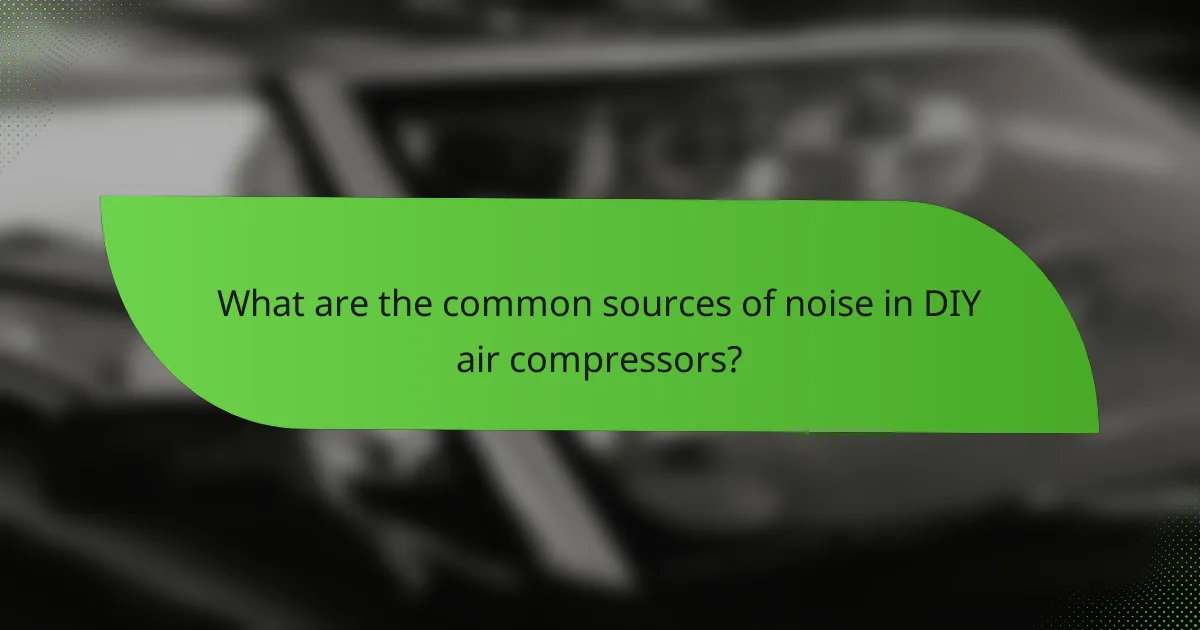
What are the common sources of noise in DIY air compressors?
Common sources of noise in DIY air compressors include the motor, vibration, and air discharge. The motor generates noise during operation due to its mechanical components. Vibration occurs when the compressor runs, causing parts to shake and create sound. Air discharge noise happens when compressed air exits the tank, producing a loud whooshing sound. Additionally, the type of compressor influences noise levels. Oil-free compressors tend to be noisier than oil-lubricated models. Proper maintenance can also reduce noise by ensuring all parts function smoothly.
What mechanical components contribute to noise generation?
Mechanical components that contribute to noise generation include the motor, compressor, and fan. The motor generates noise due to its operation and vibrations. Compressors create noise from air compression and mechanical movement. Fans contribute to noise through airflow and blade rotation. Additionally, vibration from these components can transfer to the surrounding structure, amplifying sound levels. Studies indicate that motors can produce sound levels ranging from 70 to 90 decibels. Compressors often operate in a similar range, depending on design and usage. Fan noise typically varies based on speed and design, impacting overall noise levels.
How does the motor type affect noise levels?
The motor type significantly affects noise levels in air compressors. Electric motors generally produce less noise compared to gas-powered motors. This is due to the absence of combustion processes in electric motors, which are quieter in operation. Gas-powered motors tend to have higher decibel levels because of engine vibrations and exhaust noise. Research shows that electric compressors can operate at noise levels around 60-70 decibels, while gas compressors may reach 80-90 decibels. Thus, choosing an electric motor can lead to a quieter working environment.
What role do vibration and air movement play in noise production?
Vibration and air movement are critical factors in noise production. Vibration occurs when mechanical components of a device, like an air compressor, move rapidly. This movement generates sound waves that propagate through the air.
Air movement, on the other hand, contributes to noise by creating turbulence. As air is compressed and released, it can produce a whooshing or hissing sound. The interaction between vibrating parts and moving air amplifies the overall noise level.
Studies indicate that reducing vibration through isolation mounts can significantly lower noise output. Similarly, optimizing airflow can minimize turbulence and associated sounds.
What design features can reduce noise in DIY air compressors?
Sound insulation and vibration dampening are key design features that can reduce noise in DIY air compressors. Incorporating sound-absorbing materials, such as acoustic foam or rubber, helps to minimize sound transmission. Enclosing the compressor within a soundproof cabinet can further contain noise levels. Using a larger air tank can reduce cycling frequency, leading to quieter operation. Additionally, implementing a low-noise motor or a belt-driven system can significantly decrease operational noise. Research indicates that these design features can lower noise levels by up to 20 decibels, enhancing user comfort and reducing disturbance.
How do soundproofing materials impact noise levels?
Soundproofing materials significantly reduce noise levels in various environments. These materials absorb, block, or dampen sound waves. Common soundproofing materials include acoustic panels, foam, and mass-loaded vinyl. They can decrease sound transmission by up to 30 decibels. This reduction leads to quieter spaces, enhancing comfort and focus. Studies show that effective soundproofing improves acoustic conditions in offices and homes. For instance, using soundproof drywall can lower noise levels compared to standard drywall. Overall, soundproofing materials are essential for controlling noise levels effectively.
What modifications can be made to minimize noise?
To minimize noise from DIY air compressors, several modifications can be implemented. Adding sound insulation to the compressor housing can significantly reduce noise levels. Using vibration-dampening mounts helps to minimize vibrations that contribute to noise. Installing a muffler or silencer on the exhaust can reduce the sound emitted during operation. Enclosing the compressor in a soundproof cabinet can further contain the noise. Regular maintenance, such as lubricating moving parts, can also help reduce operational noise. These modifications are supported by studies showing that sound insulation can lower decibel levels by up to 10 dB.

How can users manage noise levels when using DIY air compressors?
Users can manage noise levels when using DIY air compressors by implementing several strategies. First, selecting a quieter model can significantly reduce noise. Many manufacturers provide noise ratings in decibels (dB), allowing users to choose accordingly. Second, placing the compressor on a vibration-absorbing mat can minimize sound transmission. This method absorbs vibrations that contribute to noise. Third, enclosing the compressor in a soundproof box can further reduce noise levels. This box should have adequate ventilation to prevent overheating. Additionally, using longer hoses can allow users to distance themselves from the noise source. Lastly, regular maintenance, such as lubricating moving parts, can help minimize operational noise. These practices are supported by user experiences and product specifications that emphasize noise reduction features.
What are effective strategies for reducing noise during operation?
Effective strategies for reducing noise during operation include using sound insulation materials, installing vibration dampers, and maintaining equipment properly. Sound insulation materials can absorb and block noise. Common materials include acoustic panels and foam. Vibration dampers minimize the transmission of vibrations that cause noise. Proper maintenance reduces wear and tear, which can lead to increased noise levels. Regularly lubricating moving parts also helps to minimize friction and noise. Additionally, placing compressors on rubber mats can further reduce noise. Implementing these strategies can significantly lower operational noise levels.
How can users select quieter models or brands?
Users can select quieter models or brands of DIY air compressors by checking the decibel (dB) rating. A lower dB rating indicates a quieter operation. Many manufacturers provide this information in product specifications. Users should look for models with a dB rating below 70 for a quieter experience. Additionally, reading customer reviews can provide insights on noise levels. Brands known for quieter compressors often highlight this feature in their marketing. Researching online and comparing different models can also help identify quieter options.
What maintenance practices can help in noise reduction?
Regular maintenance practices can significantly help in noise reduction for DIY air compressors. Keeping the compressor clean prevents dust buildup, which can increase noise levels. Lubricating moving parts reduces friction, leading to quieter operation. Tightening loose components minimizes rattling sounds during use. Replacing worn-out parts, such as bearings, can also decrease noise. Ensuring proper alignment of components reduces vibrations, which contribute to noise. Additionally, using vibration-dampening pads can further absorb sound. These practices are crucial for maintaining an efficient and quieter air compressor.
What are the best practices for using DIY air compressors in noise-sensitive environments?
To minimize noise when using DIY air compressors in noise-sensitive environments, implement soundproofing measures. Enclose the compressor in a sound-dampening box to absorb noise. Use vibration isolation pads to reduce vibrations transmitted to surfaces. Position the compressor away from living areas to lessen noise impact. Opt for quieter models specifically designed for low noise operation. Regular maintenance can also help ensure optimal performance and reduced noise levels. According to a study by the National Institute for Occupational Safety and Health, soundproofing can effectively reduce noise exposure by up to 50%.
How can users create a designated workspace to minimize noise impact?
Users can create a designated workspace to minimize noise impact by implementing soundproofing techniques. First, they should select a quiet location away from high-traffic areas. Adding sound-absorbing materials, such as carpets and curtains, can significantly reduce noise levels. Users can also install acoustic panels on walls to dampen sound reflections. Utilizing a soundproof enclosure for the air compressor can further isolate noise. Sealing gaps in windows and doors prevents sound leakage. Lastly, using quieter compressor models can help lower overall noise output. Studies show that soundproofing can reduce noise levels by up to 50%.
What are the legal regulations regarding noise levels in residential areas?
Legal regulations regarding noise levels in residential areas vary by location. Many municipalities have specific ordinances that set maximum allowable noise levels. These regulations often define acceptable decibel levels during different times of the day. For instance, daytime noise limits may be higher than nighttime limits. Violations of these regulations can result in fines or other penalties. Local governments typically enforce these noise ordinances through law enforcement or designated noise control officers. It is essential for residents to check their local laws for precise regulations. Compliance with these regulations helps maintain a peaceful living environment.
What troubleshooting tips can help with noise-related issues in DIY air compressors?
To address noise-related issues in DIY air compressors, check for loose components. Tightening bolts and screws can significantly reduce vibrations. Inspect the air filter for blockages. A clogged filter can cause the compressor to work harder and produce more noise. Ensure the compressor is placed on a stable surface. An uneven base can amplify sound. Use soundproofing materials around the compressor. This can help dampen noise levels effectively. Regular maintenance is crucial. Lubricating moving parts can minimize friction and noise. Finally, consider upgrading to a quieter model if noise persists. Many newer models are designed to operate more quietly.
DIY air compressors are essential tools that operate at noise levels typically ranging from 70 to 90 decibels, comparable to a vacuum cleaner or heavy traffic. This article provides a comprehensive overview of the factors influencing noise levels, measurement techniques, and the potential health impacts of prolonged exposure to high noise levels. It also discusses design features and modifications that can reduce noise, effective strategies for managing noise in sensitive environments, and legal regulations regarding noise levels in residential areas. Understanding these aspects is crucial for users to maintain a safe and comfortable working environment while using DIY air compressors.
